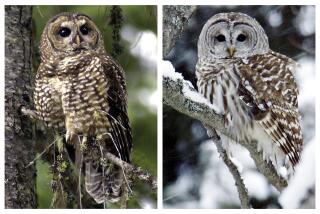White House Is Criticized for Not Using Endangered Species Act More
- Share via
WASHINGTON — The Clinton administration increasingly is striking deals with states and private companies to protect fish and wildlife, ditching the Endangered Species Act as a regulatory club except in the most dire circumstances.
The tactic landed the administration in hot water this spring with three federal judges who felt the law should have been used to protect jaguars in the Southwest, lynx in the Northwest and the Barton Springs salamander in Texas.
It also has drawn heavy fire from environmentalists, who have grown increasingly critical of President Clinton’s willingness to bargain away the law’s stringent protections.
“We are seeing a very disturbing pattern here,” said Mark Hubbard of the Oregon Natural Resources Council, a nonprofit conservation group based in Portland, Ore., that has sued the government for lax enforcement.
“We have gone from surprised to disappointed to just plain angry with the Clinton administration over their refusal to protect endangered species,” he said.
Architects of the administration’s policy say that negotiating with state and private landowners to save species makes sense in a political climate where property rights carry a great deal of weight.
The carrot works better than the stick, they argue.
“It is not a win to see a species driven to the verge of extinction and then be able to save the last of that species by hammering someone with the Endangered Species Act,” said Katie McGinty, director of the White House Council on Environmental Quality.
The administration is using the law “to its fullest and most creative extent and reaching out to save those rare ecosystems by working in partnership with people who own the land,” McGinty said.
By year’s end the administration will have negotiated habitat conservation plans covering more than 18 million acres of state and privately owned land.
Such pragmatism is no virtue in the eyes of Clinton’s environmental critics.
“Essentially it is a new way to get around enforcing the Endangered Species Act,” Sierra Club lobbyist Melinda Pierce said of the habitat conservation plans.
“It’s just feel-good politics. They have junked the law,” said Mike Bader of the Missoula, Mont.-based Alliance for the Wild Rockies, which wants federal protection for the bull trout in the Northern Rocky Mountains.
Environmentalists’ biggest beef is with a “no surprises” clause in the habitat conservation plans, which promises landowners that if they fulfill protection criteria, they’ll be insulated from any future U.S. conservation requirements.
“It’s the only way companies would ever enter into such agreements,” said Chris West, vice president of the Northwest Forestry Assn. in Portland, Ore.
In March, federal judges in Arizona, Texas and Washington state chided the administration for refusing to order protection for the jaguar, Barton Springs salamander and lynx.
In the case of the jaguar, the Fish and Wildlife Service was ordered to declare the rare cat endangered and set aside land to protect it.
In Washington, the agency was told to reconsider its decision to keep the lynx off the list; only a few hundred cats remain in a few states.
“The Fish and Wildlife Service has consistently ignored the analysis of its expert biologists,” wrote U.S. District Judge Gladys Kessler in Seattle.
In Austin, U.S. District Judge Lucius Bunton ruled that Interior Secretary Bruce Babbitt had violated the Endangered Species Act after “strong political pressure was applied to the secretary to withdraw the proposed listing of the salamander.”
Babbitt subsequently declared the salamander threatened. But environmentalists were up in arms again when the National Marine Fisheries Service decided April 25 against federal protection for Oregon’s coastal coho salmon, opting instead to give the state a chance to try its own $30-million recovery plan with support from the timber industry.
Environmentalists say an industry pledge to log more responsibly and to help restore damaged stream beds was little consolation for the Oregon coastal coho, whose stock has dropped from as many as 1.4 million in the early 1900s to about 80,000 today.
“Many of these coho runs are dangerously close to extinction and need protection right now,” said Ken Rait, conservation director for the Oregon Natural Resources Council.
“The Clinton administration has surpassed the Bush administration in both their zeal to change the Endangered Species Act and their reluctance to implement it,” said Bader, a former park ranger at Yellowstone National Park.
But George Frampton Jr., a former president of the Wilderness Society who was an assistant Interior secretary in Clinton’s first term, calls the environmental community “totally out to lunch on the Endangered Species Act.”
“A listing alone, that and a quarter is going to get you a cup of coffee,” Frampton said.
Frampton said the fewest complaints about the habitat conservation plans are heard among conservationists in California, where wildlife habitat is threatened most by development.
“Environmentalists in Southern California know that anything we don’t get protected today will be paved over in 20 years. So if we can save 300,000 or 400,000 acres of habitat for species, they look at that as a tremendous victory,” he said.
“More than 70% of all critical habitat is on private land,” McGinty said. “Without HCPs, none of these species would receive protection until they are on the brink of extinction.”
Currently, 1,081 plant and animal species are protected as threatened or endangered under the Endangered Species Act.
The Clinton administration has added 305 species to the list, compared to 228 during the four-year Bush administration and 257 during the eight-year Reagan administration, said Interior Department spokeswoman Lisa Guide.
Nearly 400 HCPs have been approved or developed in the last four years. They affect tracts ranging from one-half acre to 2 million acres, last as long as a century and cover up to 100 species.
More to Read
Sign up for Essential California
The most important California stories and recommendations in your inbox every morning.
You may occasionally receive promotional content from the Los Angeles Times.










